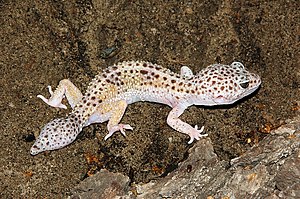AY Honors/Reptiles/Answer Key
1. What characteristics must an animal have to be classed as a reptile?
Reptiles are cold blooded animals. They are thick-skinned. Most have scales and reproduce by egg-laying. The lack of a larval stage distinguishes reptiles from amphibians.
2. Name 15 reptiles (lizards, snakes, and/or turtles) found in your locality. Tell where they live, their food habits, and their economic importance.
http://enature.org is a good resource for this. You can search local wildlife by zip code, and it also gives information about each animal.
3. Name five venomous reptiles of your area describing each as to the location of their fangs and geographical distribution.
4. Tell what to do if you are bitten by a venomous snake.
Adventist Youth Honors Answer Book/First aid/Snake bite
5. Tell what to do if you are bitten by a non-venomous snake.
Treatment of a non-venomous snakebite is essentially the same as the treatment for puncture wounds. Clean the wound, cover it with a sterile bandage, and seek medical attention.
6. Do one of the following:
a. Tell the life history of one representative of each: lizard, snake, turtle. Compare lizards, snakes, turtles, and crocodiles as to life history, variation in eyes and ears, teeth, heart, lungs, limbs, tails, and scales (shells).
Leopard Gecko (Lizard)
Leopard Geckos become sexually mature at around 10-14 months of age. The Leopard Gecko's gender can be determined once the animal reaches an adult length of 5+".
Leopard Geckos breed from March through September, although the season may begin as early as January and finish as late as October. Thirty days later, the female will lay one or two eggs with a leathery shell. Clutches of two eggs will then be laid every two weeks to monthly throughout the rest of the mating season varying from each gecko according to age, with older females gradually laying fewer eggs with each year. The eggs will need to be incubated.
Like many other egg-laying reptiles the sex of Leopard geckos are determined by incubation temperature. Eggs incubated at 79 F will result in a majority of female neonates, where as eggs incubated at 85 - 87 F will result in a more even sex ratio and eggs incubated at 89 - 90 F in the first four weeks will result in more males. Females hatched from these eggs are generally more aggressive than other females, and they tend to reach sexual maturity later if at all. An incubation temperature lower than 77 F or higher than 97 F will cause deformities and usually death of the neonates incubated at these temperatures.
The eggs hatch 6-12 weeks after being laid depending on temperature. The gecko breaks the surface of the egg and pushes its head out, remaining in this position from 2 to 4 hours adapting to lung breathing and obtaining oxygen from the egg membranes as well as absorbing yolk from inside the egg.
Garter Snakes
Before they mate, garter snakes go into brumation, which is a state similar to hibernaiton. They stop eating for about two weeks beforehand to clear their stomach of any food that would rot there otherwise. Garter snakes begin mating as soon as they emerge from brumation. In chillier parts of their range, male common garter snakes awaken from brumation first, giving themselves enough time to prepare to mate with females when they finally appear. After mating, a female leaves the den/mating area to find food and a place to give birth. Female garter snakes are able to store the male's sperm for years before fertilization. The young are incubated in the lower abdomen, at about the midpoint of the length of the mother's body. Garter snakes are viviparous, meaning they give birth to live young. Gestation is two to three months in most species. As few as 3 or as many as 50 snakes are born in a single litter. The babies are independent upon birth.
Turtles
Crocodiles
b. Keep a small reptile in a terrarium and maintain a record of its care for three months.
7. Locate two Bible stories in which a reptile played an important part.
Eve tempted by the serpent in the garden of Eden (Genesis 3)
Moses and Aaron's staffs becoming snakes (Exodus 4 & 7)
People who were bit by snakes could look at bronze snake on pole to live (Numbers 21)
Paul was bitten by a viper, which he shook off into the fire. The people thought he was a god since he didn't die. (Acts 28)

